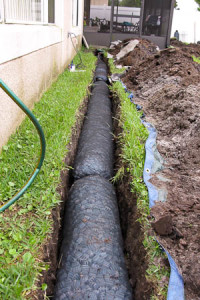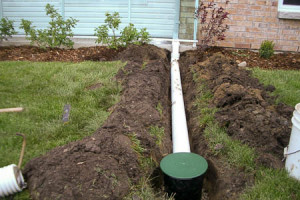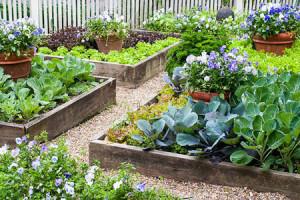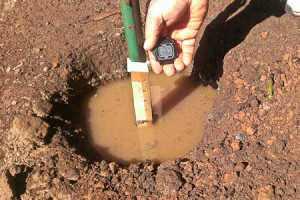Last year, North Texas experienced an exceptionally wet year due to the effects of an “El Nino” weather pattern. As a result, our drought was busted, but proper landscape drainage has never been more important to the health of your landscape and to the structural integrity of your home.
A landscape design with proper drainage is especially important where, soils are dense, land is flat or the water table is high. Well-designed drainage systems can promote healthier planting areas, reduce surface erosion problems, and reduce the possibility of home or building foundation damage.
Without proper drainage solutions for your property in place, water could collect and actually destabilize structures over time. It could also drown expensive plants and damage your landscape by essentially turning parts of your yard into a messy, wet swamp.

Installing a French drain is a good solution for redirecting surface and groundwater.
Problem #1: Surface Water
Solution: Surface Drainage
Property sites that have clay soil can encounter problems with lingering surface water. In theory, the lot was supposed to be graded to drain so that the water in the backyard flows through a swale down the side yard to the curb or storm drain. But in reality, home builders can miscalculate their grades and water becomes trapped, causing muddy zones in lawns and planting areas.
A surface drainage system consists of shallow ditches and should include land smoothing or land grading. When your landscape designer creates the new drainage plan, it may include surface grading to ensure there is enough of a slope to drain. If there is not, alternatives for drainage are available. The French drain (or weeping tile) is a trench filled with gravel or rock or containing a perforated pipe that redirects surface water and groundwater away from an area and provides a place underground where it may take its time percolating down through dense soils. Roofing felt or geotextiles are laid over the top of the gravel and the soil replaced. The surrounding area is graded to drain to this trench so water no longer gathers on the surface to create problems.

An underground drainage system is worth the investment in areas of high rainfall.
Problem #2: Hardpan
Solution: Underground drainage
Hardpan is a dense layer of soil- usually found below the uppermost topsoil layer- that is largely impervious to water. Where hardpan layers exist, the entire site may suffer poor drainage and standing water, and spot drainage is not sufficient.
The solution for hardpan is a site-wide grading and drainage plan with an underground system of pipes fed by drop inlets or trench drains. An underground drainage system can cost more to install, but it is worth the investment, especially in areas of high rainfall. Where there is no storm drain available, this kind of system may flow into an underground sump. This is a large hole dug and packed with gravel where water stands until it drains away. With luck, digging of a sump punches through hardpan into more porous soils deeper down.

Raised planters are an effective solution for high water table landscapes.
Problem #3: High Water table
Solution: Use water-loving plants or raise planting areas
Low lying areas with a high water table present many challenges for a landscape design. Roots of plants that have been in saturated soil during the growing season are deprived of oxygen and will quickly rot like a house plant that has been over watered.
If your yard has a high water table or poor drainage it can be difficult to grow most types of trees. However, there are certain types that originate in river bottoms and wetlands and can thrive in high water landscapes, such as willows, palmettos, birch trees and selected maples and oaks.
Another solution for high water table landscapes is to raise the planting areas, an expensive but effective option. There are a variety of raised planter heights that can suit everything from trees and large shrubs to smaller shrubs and perennials.

When testing for drainage problems, water should drain away within an hour.
Test your landscape’s current drainage
Find out what’s going on underground with this simple test. Dig a hole about two feet deep and as wide. Fill it to the top with water. If it drains away within an hour your drainage is excellent. If it takes 12 hours to drain, there may be problems. If it takes more than 24 hours to drain, then there is a serious problem that could impact the deep root zone of trees and shrubs.
If your landscape has drainage problems, contact us the professionals at Simpson Landscape today. We specialize in installing and maintaining proper drainage solutions for your property.
(Source: Landscaping Network)

